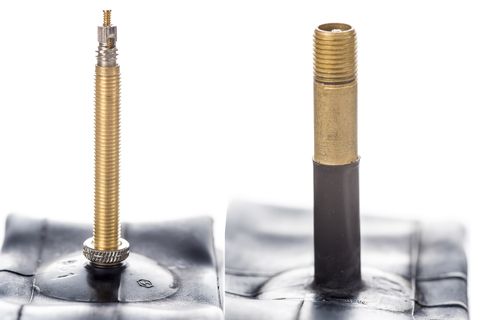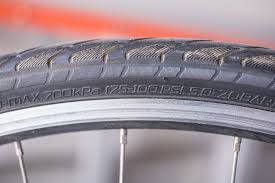
Left is presta; right is schrader.
Sometimes when I’m riding I hear the pffFFFFTTT of a blowout when I’m riding my bicycle. Sometimes when I’m riding I notice the steering or pedaling get sloppy. Sometimes I pull out my bicycle I notice a flat or low pressure tire. I know I have to fix the flat. Those are all times we need to consult mohrnet and fix a flat. I always ride with a spare tube, a pump and a couple of tire irons to replace a flat tire. Without them you’re at the mercy of others. I don't usually repair the tube out on the road. I just replace the tube. I like to be independent. Over the years I’ve learned to fix everything on my bike except a broken frame. So I want to give an explanation on replacing a tube. Of course it’s critical to have a tube that fits your bike when you’re out. On the tire you should be able to find the size written in two different measures – metric and standard measure. The standard modern road bike has 700c wheels. So the tire measure starts with 700 and the second dimension is the circumference which is typically 23mm. So the specifications you’d give the bike shop or search the internet for would be 700x23. A mountain bike wheel is based in inches and is usually 26”. That is also written on the tire. If you’re not sure ask a bike shop when you buy a tube.

Left is presta; right is schrader.
The other specification to notice when reading the sidewall of the tire is the inflation specification. How much pressure is standard for the tire? There are also two measures for that – bars and PSI. Most pumps offer both. The third thing to notice when you’re buying or repairing a tube is the valve type. There are two valve types – presta and schrader. Schrader is the type you’re probably familiar with. They’re used on car tires. Presta are used mostly with road racing bikes from my experience although a lot has changed over the years. A lot of bike pumps will have both types of fittings but it’s something to keep in mind. There are also adapters available to service presta valves with a Schrader pump.

The writing is difficult to read but this is where you find the tire pressure and other specifications.
To replace a tube you have to remove the tire from the rim. If you’re not careful you can damage the old tube further while removing the tire. You can also damage a new tube by pinching it with the tire iron when installing. Be careful. Heads up: Your hands will likely get dirty repairing a tube.
You start by taking the tire iron and with the curved surface up squeezing it under one side of the tire bead to pry it away from the rim. You’ll learn by experience to be careful because you can also grab both sides of the tire bead and that will not succeed in getting it off the rim. Lift off one side of the tire bead with your two tire irons and pull it over the rim. Get all of that bead off one side of the entire rim (all the way around). Then you can reach under the tire and pull out the tube. If you have a presta tire there may be a nut holding the tire to the rim. You’ll need to take the nut off to pull the tire nozzle thru the rim.
Make sure you check the inside of the tire. Sometimes a shard of glass or wire is sticking thru the tire and will puncture the new tube. Also check to make sure the rim liner or rim tape is in place. This keeps the tube from rubbing against the spoke nipples. Inserting the tube take care to not let the tube fold. It's helpful to insert a little air in the tube. That makes it easier to install. After the tube is installed pump the tire up halfway. Bounce it around on the ground to make sure it's sitting in the right place with the rim.